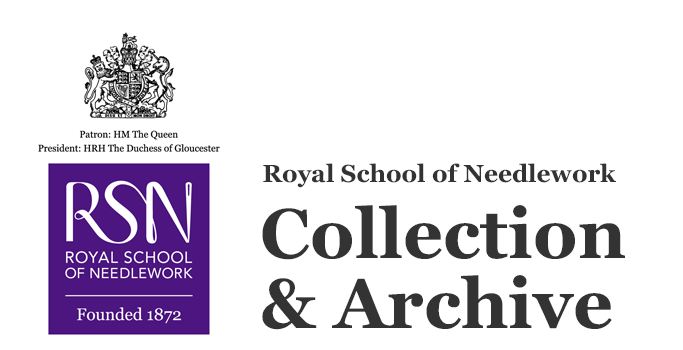Picture
Object name
Date made
Circa 1780-1800
Place made
Description
Circa 1780-1800 round embroidered picture with pearls, metal threads, and painted tableau of two children in its centre.
Content description
Circa 1780-1800 embroidery and painting on silk, framed in its original round frame. The whole embroidery is on silk with a central painted medallion showing two children. The younger of the children is holding an apple and the older child is dressed in a blue dress with a blue ribbon in her hair. This picture has been painted on to the fabric, probably using watercolours.
The picture is encircled by a silk cord which is couched. Around the cord are pearls. And surrounding the pearls, on the outer edge, are sequins tacked down with silk-wrapped purl. This central tableau is surrounded by a garland of stems and leaves made of silk-wrapped purl in a variety of colours. The picture of the girls is ‘hung’ by a ‘ribbon’ made from chenille thread. The ‘ribbon’ hangs from a bow and garland of pearls. On each end of the garland of pearls are two tassels made of chenille and silk-wrapped purl. It appears that the pearls used throughout the piece are imitation pearls, made by blowing small glass globes and coating the inside with a paste made from fish scales.
This embroidered picture is typical of embroideries from this period, with its silk ground and combination of embroidery and painting. The central picture is possibly taken from John Russell's 1777 pastel of two children, which was exhibited at the Royal Academy in 1778, or from an engraving of it. The sitters have wrongly been ascribed as Miss Elizabeth and Miss Frances Earle in later sales of the pastel picture. Both were born after 1777. John Russell (1745-1806) was the foremost pastel artist of his time. He exhibited more pastels at the Royal Academy than any other artist and left a far larger body of work than any other pastellist working before 1800. He was appointed crayon painter to the Prince of Wales in 1785 and became painter to the King in 1790. His manuscripts and diaries are held at the Victoria and Albert Museum.
His works were often copied by engravers, which could explain why the picture in the embroidery differs from the original work. The original shows the older child to be dressed in brown and younger child is wearing a bonnet. Engravings allowed paintings to be accessed by a much wider audience. They would appear in books and magazines and were readily available from printsellers, allowing amateur embroiderers and artists to copy them. As was the case for many embroideries in this period, it is likely that the painting is the work of a professional painter rather than the embroiderer herself.
The picture is encircled by a silk cord which is couched. Around the cord are pearls. And surrounding the pearls, on the outer edge, are sequins tacked down with silk-wrapped purl. This central tableau is surrounded by a garland of stems and leaves made of silk-wrapped purl in a variety of colours. The picture of the girls is ‘hung’ by a ‘ribbon’ made from chenille thread. The ‘ribbon’ hangs from a bow and garland of pearls. On each end of the garland of pearls are two tassels made of chenille and silk-wrapped purl. It appears that the pearls used throughout the piece are imitation pearls, made by blowing small glass globes and coating the inside with a paste made from fish scales.
This embroidered picture is typical of embroideries from this period, with its silk ground and combination of embroidery and painting. The central picture is possibly taken from John Russell's 1777 pastel of two children, which was exhibited at the Royal Academy in 1778, or from an engraving of it. The sitters have wrongly been ascribed as Miss Elizabeth and Miss Frances Earle in later sales of the pastel picture. Both were born after 1777. John Russell (1745-1806) was the foremost pastel artist of his time. He exhibited more pastels at the Royal Academy than any other artist and left a far larger body of work than any other pastellist working before 1800. He was appointed crayon painter to the Prince of Wales in 1785 and became painter to the King in 1790. His manuscripts and diaries are held at the Victoria and Albert Museum.
His works were often copied by engravers, which could explain why the picture in the embroidery differs from the original work. The original shows the older child to be dressed in brown and younger child is wearing a bonnet. Engravings allowed paintings to be accessed by a much wider audience. They would appear in books and magazines and were readily available from printsellers, allowing amateur embroiderers and artists to copy them. As was the case for many embroideries in this period, it is likely that the painting is the work of a professional painter rather than the embroiderer herself.
Dimensions
width: 35.5cm
height: 35.5cm
depth: 3cm
height: 35.5cm
depth: 3cm
Materials
Stitches
Techniques
Motifs
Credit line
Gift of Juliet Childs, 2022.
Catalogue number
RSN.2675
© Royal School of Needlework

